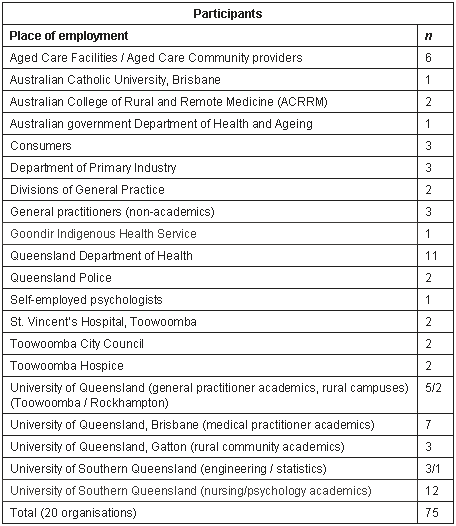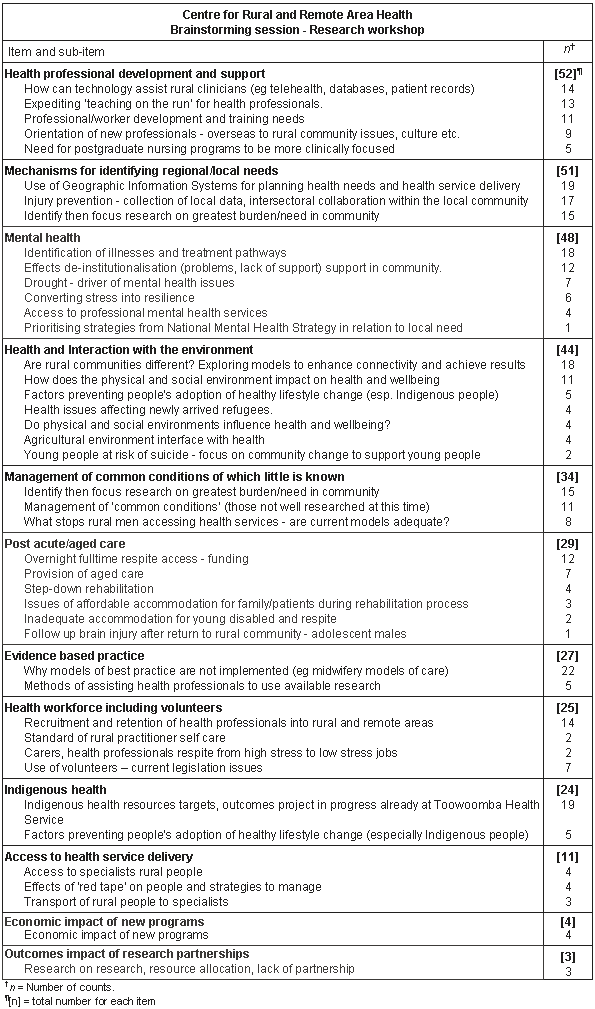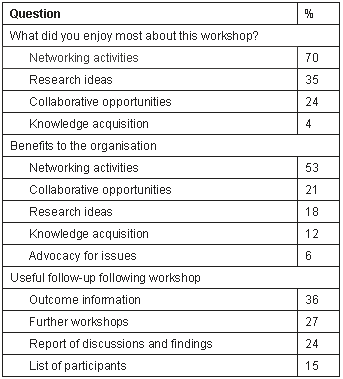In January 2002, the University of Queensland (UQ) School of Medicine, Rural Clinical Division, South West Queensland Region was established, based at Toowoomba, with funding from the Commonwealth Department of Health and Ageing. This initiative forms part of the Australian Government strategy to improve rural medical workforce recruitment and retention, and it is a requirement of the Department of Health and Ageing that, from January 2004, at least 25% of students will undertake 50% of their clinical training within one of the 10 national Rural Clinical Schools.
Toowoomba is situated approximately 100 km west of Brisbane, the capital city of Queensland, Australia on the edge of the Great Divide. It has a population of approximately 89 000 people1. Until the formation of the Centre for Rural and Remote Area Health, the only rural health research centre was located at Mt. Isa in north-west Queensland. It was apparent that there was a need for a rural health research Centre which could work with health practitioners and other industry partners in southern Queensland
From 1 July 2003, a formal collaborative relationship with the University of Southern Queensland (USQ) Centre for Rural and Remote Area Health (CRRAH) and the Rural Clinical School was established to maximise regional research opportunities for both Universities and regional organisations. The major challenge for the Joint Centre was seen as the identification of regional research needs2, rather than relying on 'top-down' National Priority Issues to define the agenda. Obtaining funding to develop and implement relevant projects was a challenge that flowed from this.
In order to set a regional research agenda, an interactive research workshop was planned and included local clinicians and other key stakeholder participation (Table 1). This followed the needs analysis method of Murray, where the views of key local stakeholders were sought as part of a rapid appraisal process3.
Table 1: Detail of number and organisations of research workshop participants

Method
Selection of Participants
A total of 75 participants from 45 organisations representing 20 separate entities attended the workshop. These organisations represented the key consumer, academic and health professionals groups within the Toowoomba region. All organisations had been sent a letter inviting them to attend and to send at least one representative and to notify of their ability to attend. One complicating factor was that some uninvited participants turned up at the workshop, making the venue somewhat crowded.
The majority of participants were health professionals employed at USQ, UQ or Queensland Health. However, there were also representatives from aged care providers (community and residential care); one of the two private hospitals within Toowoomba; the Toowoomba Hospice; and the Indigenous Health Service located in Toowoomba. Representation also included organisations such as the police, the local city council and self-employed general practitioners and psychologists. Only two of the eight invited consumer representatives were able to attend, thus decreasing the consumer voice in the workshop.
Design of the workshop
The workshop was planned as an interactive research workshop using rapid appraisal. All staff from CRRAH were involved in deciding the design of the workshop. To identify key areas of research need, the nominal group technique was used as the group process is strictly controlled by the facilitator who manages information flow, essentially acting as a collector of the ideas of each member of the group4. In these circumstances the facilitator does not lead the discussion. True to this group technique, there were four other personnel who acted as note-takers, allowing the group process to flow quickly from one participant to another. This technique was useful for this group of participants as it was apparent that some participants may have remained silent due to the presence of more dominant personalities and power differences within the group.
The nominal group technique allowed all workshop participants to have an equal say within the workshop situation. It also ensured that ideas of members were shared and commented on by all the participants in a non-threatening environment. Once all group members had an equal say about the topic, the ideas were thematically analysed by the facilitators and then all participants ranked each of these themes by importance (in this case the participants were given five 'dots' to place next to the theme/s important to them).
Results
Research Topics
Forty-three topics were put forward by participants during the nominal group technique plenary session. From these, 12 major themes were evident. The themes and sub-themes which arose from the data analysis are outlined (Table 2).
Table 2: The themes and sub-themes of the workshop data analysis

Group discussions
Five subject areas from four themes were chosen for further small group discussion. A summary of the views, ideas and conclusions of each group, which were presented to a plenary session of reassembled participants over a 10-15 min period by each group facilitators, are discussed below. Following each presentation, a 5-10 min question session was provided after each topic. The outcome of these discussions were not recorded and are therefore not reported in this article.
Evidence based practice: This discussion centred around a number of case studies in which evidence-based best practice was implemented to varying degrees, depending on a number of internal and external factors. These included:
- The ability to identify, synthesise and properly evaluate relevant literature and information was felt to be of key importance in the preparatory phase of change introduction.
- Successful implementation appeared to the group to depend to a significant degree on the development of packages of interventions, in a staged manner, to allow time for organisational attitudes and culture to adapt to new ideas and work practices.
- Ownership of change processes by those affected was also felt to be important to success. In particular, the group believed that new methods would need to be seen as relevant to organisational needs, cost effective, feasible and beneficial in terms of improved outcomes for stakeholders. In this regard, a focus on 'bottom-up' rather than the usual 'top-down' approach to organisational change was felt to be likely to improve the chances of success.
- Limited human and financial resources were pinpointed as common reasons for failure to adopt best practice.
- Intra- and inter-organisational rivalries at both group and individual levels, often related to vested interests, were also regarded as commonly encountered obstructions to the introduction of change.
Future research: No specific areas of future research were identified.
Mental health: A large range of topics was discussed by this group, which covered three main areas:
- Indigenous mental health There were several issues that were seen to impact on Indigenous mental health. These were that:
- Aboriginal health workers cannot be expected to deal with mental health.
- Community education is lacking.
- The manner in which outcomes measures are going to relate to Aboriginal people remains to be determined.
- Early intervention is crucial
- Cultural awareness programs are required.
- Lack of community support as the result of de-institutionalisation is a major factor in high relapse rates.
- Aboriginal health workers cannot be expected to deal with mental health.
- Youth The issues identified surrounding youth mental health were that:
- For young people with disabilities, drug involved psychosis commonly co-exists, so they are very vulnerable in the community.
- The shortage of boarding house accommodation is a significant adverse factor.
- A strong link exists between drugs and mental illness (co-morbidity), which needs to be more clearly recognised.
- For young people with disabilities, drug involved psychosis commonly co-exists, so they are very vulnerable in the community.
- Community Support There were several issues identified by participants relating to community support:
- Support networks, especially emotional and social supports, need to be identified and provided to enable vulnerable people to live successfully in the community.
- Dealing with government departments can often be very difficult.
- The current model for supported care of chronic types of mental illness is wrong; some of these people need supported accommodation for life but this option is lacking.
- There is little local availability of accommodation in rural areas; boarding house accommodation is not necessarily ideal for those with mental health problems.
- Removing people from their communities is devastating; being part of community life is stabilising.
- A broad range of accommodation options is urgently needed to cater for people of various ages with differing mental health issues.
- People with mental illness would benefit from access to major centres in terms of comprehensive evaluation, including precursors, co-morbidities, and socioeconomic factors.
- Relevant community information needs to be pooled and effectively disseminated.
- The notion that untrained personnel can provide mental health care within the community needs to be dispelled as neither cost effective nor efficacious.
- Support networks, especially emotional and social supports, need to be identified and provided to enable vulnerable people to live successfully in the community.
The consensus of the group was that a central issue was the lack of effective community supports for patients. Two approaches to researching this were proposed: (1) a broad meta-analysis of community needs; and (2) a more specific study examining the effectiveness of long term supported accommodation (which could be a controlled trial, comparing outcomes for those randomly allocated to a service to those receiving tailored care).
Health and interaction with the environment: Within this group a number of core issues were identified. These were:
- There was complete agreement amongst the members of this group that a significant problem was the use of urban models of service delivery in rural and regional areas without due consideration of the among between urban, regional and rural areas, as well as between different regional and rural areas.
- Values were felt to be a core issue. For example, was the assumption that rural people want the same services as urban people in fact correct? Also, what factors perpetuated current models that might not be working?
- A great deal of knowledge and expertise about rural issues was perceived as being evident within the group. This was felt to exemplify the existing personal, practical knowledge needing to be tapped into, to craft a 'bottom up' model designed to respond to the needs of rural and regional people.
- Many different groups of people in rural and regional areas were identified. These included newly arrived refugees, immigrants, Indigenous peoples, and people who had retired to rural or regional areas from the cities or off the land, as well as farmers, professionals, business people.
- The 'mix' of demographics was seen as varying from community to community, with the result that health systems had to be flexible and responsive to local needs.
- Living in a rural area could be quite different for a person who was established and hence accepted within the community, as opposed to those who were seen as 'outsiders' and hence might not have access to the informal support systems in these areas.
To identify more appropriate models, a qualitative narrative/appreciative inquiry, using interviews and focus groups, was proposed as a suitable method of researching four important issues:
- Mechanisms for tapping into personal practical knowledge and the community knowledge of key stakeholders in selected rural areas (eg consumers, health professionals, representatives of community groups).
- The identification of common features across different communities, as well as dissimilarities;
- The development and implementation of effective models of service and delivery by local communities; and
- The identification and description of a rural services delivery system incorporating the flexibility to respond to different rural and regional settings.
Mechanisms for identifying regional/local needs: There were two specific issues discussed by participants in separate small groups.
Injury mechanisms Key points raised were as follows:
The World Health Organisation (WHO) has established policy guidelines for development of 'safe communities', confirming the international importance of personal safety and injury prevention.
- There is lack of local data on where injuries were occurring. For example, workplace, agricultural, falls at home, sporting fixtures, events presented major difficulties in injury prevention were areas thought to be the causes of injury.
- There was a need for local data collection and a central registry to record injuries and evaluate risk.
- While information was being collected locally in certain situations, such as the Public Hospital Emergency Department, this was not being collated with information potentially available from sources such as private medical practitioners, ambulance personnel, workers' compensation, or contract workers who did not report injuries.
- Maximisation of data collection regarding injuries and their causes was of paramount importance.
- There was a need to identify trends and priorities.
- Key stakeholders needed to be linked, and be working towards the same goals.
- A council-based research reference group 'Building on Safe Communities' is already established could form the framework for future collaborations to identify and implement injury prevention strategies within the local community.
A number of research questions were formulated:
- What strategies can be implemented to maximise data collection of rural injuries?
- What injuries warrant injury prevention programmes (need for a risk calculator as risk indicator)?
- What is effective in regard to community care and supports?
- How can the lack of available services be evaluated?
Geographical Information Systems (GIS) and other data and their application within health Following a brief overview of the concept of GIS use by the more experienced members of this group, its role in regional health and community development was discussed as summarised below:
- It could be used to track and/or trace communal diseases and injuries.
- The design of prevention strategies would be benefited by evaluating local or regional patterns of relevant conditions and trends in incidence.
- A more relevant framework could be developed to manage whole health service information systems.
- Widespread data sources relating to common issues should be centrally compiled wherever possible, to maximise their value in policy development and relevant research activities.
The session then moved on to examine a number of questions and issues relating to the practical use of GIS and other data:
- How could or should data be applied to policy decisions? (This was regarded by some group members as equivalent to using clinical data for clinical decisions)
- Are the right questions being asked?
- There appeared to be a number of barriers to use, including data quality, refinement, turnaround time, difficulties in the classification of many conditions, information ownership, privacy and confidentiality,
- Collecting data was relatively easy compared to developing algorithms/decision aids.
- Current approaches to spatial information use may be inefficient and/or lacking adequate distribution
- Although 'burden of disease' and morbidity/mortality type data existed in many different areas, these often failed to provide a sufficient level of detail.
- Identification of specific applications encouraged appropriate data collection
- Data collection should be based on the prior development of specifically designed algorithms
- Mapping information had the potential to provide unique insights into local or regional activities and phenomena.
- Information was lacking in regard to the degree to which spatial information data acquisition correlated with relevant decision making.
At the end of the discussion there was general agreement within the group that the priority for regional research involving spatial information centred upon agricultural injuries and incapacitating disease patterns in various local geographic areas. It was expected that by tracking what was happening at a local level, more effective prevention strategies and management policies could be developed.
Workshop evaluation
At the conclusion of the workshop, participants were asked to complete an evaluation questionnaire containing four questions. Thirty-four completed forms were received from the 72 participants - a return rate of 47%. Three of the four questions were closed and the results are outlined (Table 3).
Table 3: Workshop evaluation

The fourth question asked participants to provide any other comments they wished. Twenty-six of the 34 respondents provided a response to this question. Nineteen (73%) simply expressed their thanks because they found the workshop helpful and valuable. A further six (23%) while also expressing their thanks, provided some guidance to future workshops. Only one participant stated that they had no benefit from attending the workshop.
Discussion
This article has described the approach taken to research planning by a CRRAH research developed as a collaborative joint organisation between USQ and UQ. Resultant initial outcomes have also been outlined. From the outset it was recognised that research in rural and remote areas should use the methodology which best answers the research question/s. It was particularly noted that well-designed qualitative research was as applicable as quantitative research within a rural and remote environment.
The majority of research personnel in Australia are to be found working in specialised centres close to relevant infrastructural support situated predominantly in metropolitan areas. This is particularly true of experienced senior researchers, with the result that large project grants from major funding bodies such as the National Health and Medical Research Council or Australian Research Council, usually designed to address national priorities, are predominantly awarded to urban-based collaborative research groups. In addition, by reason of the relative lack of physical infrastructure, equipment and personnel, research in rural and remote areas is more frequently qualitative than quantitative in nature5, further limiting opportunities to gain funding.
The concept of working in collaboration with local communities, organisations or individuals therefore has immediate attractions not only in broadening project opportunities but also increasing the potential workforce pool. To be effective, this approach requires good communication and interpersonal skills to develop appropriate research activities, with the result that rural researchers often require a different attitude and skill set to their urban colleagues. With these factors in mind, it was felt that engagement of the regional community could best be obtained in a sustainable manner by focusing on issues of local relevance, rather than simply developing project applications designed to address issues identified by various funding bodies. That is not to say that such issues were ignored or precluded, but that local relevance was regarded as of precedent importance.
It can be seen from the results that the attempt to gain regional support and input to develop research activities which would address local needs appeared to be well received, with a large number of participants from a wide range of local organisations attending the workshop. The significant number of issues raised during the brainstorming session also indicated considerable research interest, and the group discussions further reflected this. Feedback from participants was very positive in over 90% of responses to the evaluation questionnaire, with the ability to meet to discuss ideas and establish networks seen as the major benefits.
One outcome of the workshop was that while national research priorities (for example, mental health) were identified as important within the south-east Queensland area, other priorities were equally ranked. For example, injury prevention, rural health service delivery (including the use of GIS for health service planning) were areas that are not, at present, considered to be national priorities.
Additionally, it was also apparent that there was considerable interest among the workshop participants about how they would implement the growing amount of evidence now available on which to base their practice.
Conclusion
The provision of a workshop, designed to enable rural and remote organisations and regional researchers to meet together to identify local research needs appeared to be well received. A number of areas for relevant research activities were identified, which have since translated into at least one major collaborative community-based project for which a funding application has been developed and funding applied for. Further research areas have been identified for future programs, but the benefits of the workshop based on a relevance-focused approach remain to be determined.
References
1. Australian Bureau of Statistics. 2016.3 Census of Population and Housing: Selected Characteristics for Urban Centres, Queensland. Canberra, ACT: ABS, 2001.
2. Queensland Government. Supporting R & D in the regions: Queensland R & D Strategy Issues Paper. Brisbane, QLD: Queensland Government, 2002.
3. Murray SA. Experiences with 'rapid appraisal' in primary care: involving the public in assessing health needs, orientating staff, and educating medical students. BMJ 1999; 318: 440-444.
4. O'Neil MJ, Jackson L. Nominal group technique: a process for initiating curriculum development in higher education. Studies in Higher Education 1983; 8: 129 138.
5. Curtis S, Geslen W, Smith G, Washburn S. Approaches to sampling and case selection in qualitative research: examples in the geography of health. Social Science & Medicine 2000, 50: 1001-1014.





